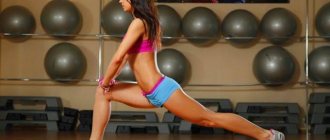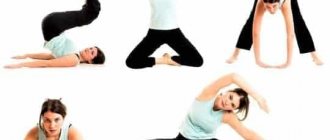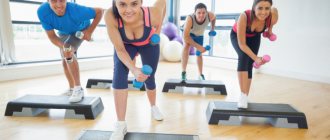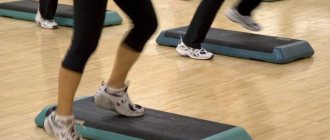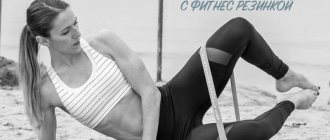As a rule, step aerobics classes are extremely beneficial, but in some cases they can harm your body.
If you have been doing step aerobics for long enough, you have probably repeatedly thought about what effect these workouts have on your body. Today I will talk about the benefits that step training brings to our body and in what cases step aerobics can be harmful. The benefits and harms of step aerobics (either the first or the second) appear depending on how competently you approach your training.
Step aerobics is a type of health fitness that was invented in America in the eighties of the last century. The basic principle that forms the basis of step aerobics is the principle of going up and down steps.
This movement mechanics has a positive effect on the leg joints, in particular the knees, improving their mobility and strengthening the surrounding muscles. To the boring walking up the steps, classical aerobics exercises were added, performed to rhythmic music.
This is how step aerobics appeared - one of the most interesting areas of group fitness training. Step aerobics combines the beneficial properties of classical aerobics and exercises that have a beneficial effect on the joints of the lower extremities. What are the benefits of step aerobics? I will talk about this below.
Does step aerobics help you lose weight?
In order to lose weight, you need a comprehensive approach consisting of diet and exercise. Step aerobics is a good way to lose weight precisely because it is very energy-intensive.
In the first 20-30 minutes, quickly accessible carbohydrates (glycogen) are consumed, which are deposited in the muscles throughout the day, however, after 25-30 minutes, it runs out, and the body has to “process” deep fat reserves, due to the elimination of which weight loss occurs.
The energy consumption of a workout is directly related to the type of step aerobics. So, with low-intensity exercise, approximately 250-270 kcal per hour is spent, at an average level - 350-400 kcal, but high-intensity exercise will burn more than 500 kcal within an hour.
Attention! Accordingly, weight loss with this type of training depends solely on the complexity of the program and the preparedness of the athlete. Regular exercise speeds up metabolism, as a result of which calories are intensively burned within 24 hours after the last workout.
By exercising 3-4 times a week and adjusting your diet, you can achieve tangible results within a month.
Be sure to watch: Basics of step aerobics: a complex for beginners Slim figure and great mood - step aerobics for weight loss at home What is step aerobics
Step push-ups
Often standard exercises are supplemented with a step platform to enhance the load and effect of the exercises. For example, classic push-ups can be complicated in this way:
- The starting position is done so that the forearms are on the platform and the legs are straight out parallel to the floor;
- Using your fingers, you need to fix the position of the body;
- While in this position, you need to straighten your back and tense your stomach, without bending your lower back;
- Alternately straighten your arms, slowly push up and return to the starting position;
- The exercise is repeated at least 10 times.
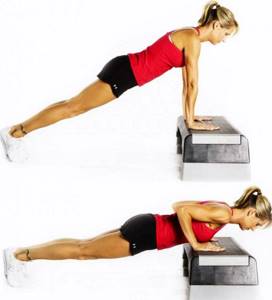
Step options
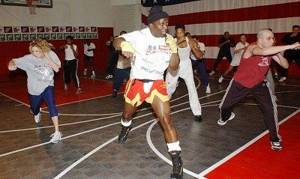
At its core, step aerobics is a combination of individual elements - steps. They are conventionally divided into steps with and without changing the leading leg. Each of them is performed on several accounts.
The main basic elements of step aerobics:
- Basic Step . Performed on 4 counts. It is a simple climb onto the platform. First with one leg, then the other, then descend with the first leg, then the second.
- V-Step . Almost analogous to the first type, with the difference that the foot stands on the corner of the stepper, so the step is taken wider. Also done on 4 counts.
- Over . Easy cross platform sideways. Performed in 4 counts, also gradually moving the legs. On the 4th count, the foot does not stand completely on the floor, but only touches it with the toe.
- Straddle . Direct transfer through the platform to 8 accounts. For the first 2 counts the athlete stands on the apparatus, for the second 2 he goes down to the floor, and for the remaining 4 counts he returns back in the same order.
- Turn Step . Similar to Basic Step with side release. Performed on 4 counts.
- Knee Up . Cross step to the opposite corner of the platform while raising the knee. This is done in 4 counts, like most basic steps.
- Step Kick . The same cross step, but not with raising the knee, but with a strike to the side. The element is taken from kickboxing. Also performed on 4 counts.
- L-step . An element that is somewhat difficult for beginners, including a cross step with raising the knee, then transferring the weight to the leg straightened and lowered next to the stepper, and returning back in a similar way. Performed on 8 counts.
Each of the basic elements can be modified and included in any combination. Hand movements, jumping, skipping, and clapping can also be added.
This variability makes step aerobics an interesting and varied workout.
Step aerobics is a type of cardio training based on performing dance elements using a special step platform. It can be considered one of the most effective ways to achieve weight loss and the formation of a beautiful figure, without exceeding your physical capabilities.
This type of aerobics is available to everyone, regardless of gender, age and physical fitness. In addition, you don’t have to visit fitness clubs to exercise; you can do it at home, on your own, using video lessons.
What is step aerobics and how did it appear?

Step is considered a subtype of sports aerobics. Its distinctive feature is that the exercises are performed on a hill. To create such a hill, a step platform is used. Although, if desired, the platform can be replaced with any other similar device. The workout consists of a series of alternating steps performed in different combinations, and changing the height of the step due to the platform increases the load. Classes are held very intensively, at a high rhythm and with almost no time for rest.
The founder of tap dance is Gene Miller. Having suffered a knee injury in 1989, Jean, on the recommendation of her doctor, developed her joints by stepping on a wooden box. The recovery went well, and walking at elevation showed good results in strengthening the muscles of the lower extremities. All this prompted Miller to develop a training program based on such walking.
In the 90s 20th century Step aerobics has gained incredible popularity. The emergence of new types of fitness initially relegated it to the background, but since 2015 it has been in demand again.
The essence of the training
Step involves performing a set of basic steps , combined in combinations in various variations, varying in complexity. Classes are accompanied by rhythmic music. The step platform is a plastic frame with a non-slip surface and adjustable height. Changing the height allows you to increase or decrease the load.
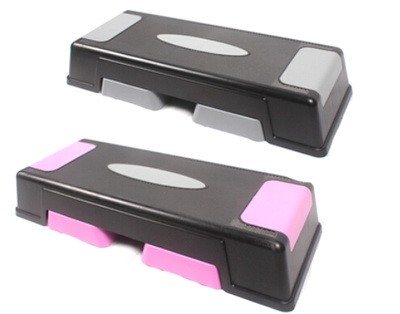
At the beginning of the workout, there is a warm-up based on basic steps. Further, walking becomes more complicated, combinations of steps are connected. For beginners, simple combinations are used, 2-3 steps, no more. And experienced athletes perform complicated variations at an even higher rhythm. At first, repeating the movements simultaneously with the instructor will not be easy, but after a couple of workouts the body will get used to the loads, and the steps and combinations will be recorded in memory.
The duration of one workout is from 45 minutes. up to an hour. Participants walk without breaks, the intensity and complexity of the exercises gradually increases, and walking in place is used for relaxation. Sometimes at the final stage of classes, exercises are performed for the muscles of the arms and abdominals. This is done to work out more muscles, because step aerobics mainly affects the legs and buttocks. For the same purpose, arm swings are performed, activating the work of the shoulders. Often the load is increased by using small dumbbells.
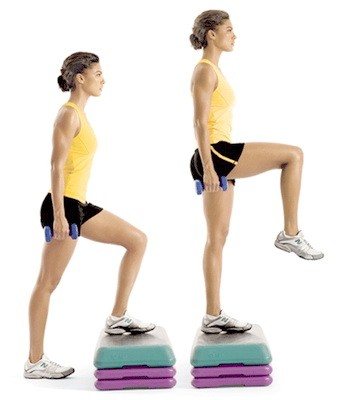
As a general rule, a group step class involves an average level of difficulty. But it is possible to independently increase or decrease the load by adjusting the height of the platform. It is also recommended to attend a trial lesson in advance to get an idea of the training program.
Types of step aerobics
Depending on the intensity and complexity, there are 4 main types of training:
- Step-basics. Suitable for beginners because it uses simple steps and sequences, and the lesson itself does not last long. Designed to adapt to the loads of the muscles, heart, blood vessels and respiratory organs, as well as to memorize basic exercises and develop a sense of rhythm.
- Step 1. This is a classic activity of medium difficulty level. At this level, the duration of the training increases, its intensity increases, and the load increases.
- Step-comb. Designed for those who have been practicing regularly for several years. The exercises include complex combinations.
- Step-interval. A workout that alternates strength and aerobic exercises with the addition of plyometric and static elements.
Advantages and disadvantages

Step aerobics has many advantages, which has led to an increased demand for it among cardio workout enthusiasts.
Benefits from classes:
- Effective and quick disposal of extra pounds - about 300-500 kcal are burned in an hour of walking.
- Safety for joints.
- High-quality training of the muscles of the thighs and buttocks, allowing you to significantly reduce their volume.
- Prevention of osteoporosis and arthritis, primarily necessary for those who lack physical activity in everyday life.
- Improving the functioning of the heart and lungs and, as a result, reducing the risk of developing various diseases in this area.
- Maintaining normal body weight, which reduces the likelihood of diabetes, stroke, metabolic problems, and joint pain.
- Increases the overall endurance of the body, coordination of movements and sense of balance.
- Weight-bearing exercises help increase bone density, which prevents the development of bone diseases.
- The opportunity to practice not only on a commercial basis, but also at home.
Walking on the steppe, like any other type of physical activity, has a number of disadvantages and contraindications.
Among the disadvantages are:
- Difficulty performing many combinations that take time to master. For many people, the desire to exercise disappears even at the first training session, because they get lost, confused and do not keep up with the others.
- If you have problems with your knee joints, step aerobics can aggravate the disease.
- Not all classes are equally effective, since trainers often add something of their own to the training program.
- Correct walking technique is of great importance, otherwise the Achilles tendon will be overloaded. The worst-case scenario would be injury or rupture.
Indications and contraindications
Stepping is not only a workout for weight loss, but also a fairly balanced load on the body. This makes it suitable for solving a whole range of problems, such as:
- Improving heart function and vascular patency.
- Vestibular apparatus training.
- Increased endurance and strength.
- Correction of posture.
- Strengthening joints and spine.
- Toning the muscle complex.
- Prevention of insomnia, depression.
- Increasing the body's resistance to viruses.
- Normalization of blood pressure.
Step training is contraindicated if:
- Osteoarthritis of the knee joints.
- Varicose veins.
- Intervertebral hernia.
- Hepatic and renal pathologies.
- Acute cholecystitis.
- ARVI.
Required equipment
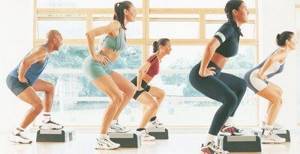
The list of necessary equipment is very small: a step platform and sportswear. As already mentioned, the platform can be temporarily replaced with another device. You can also purchase two collapsible dumbbells to complement your workout with strength exercises.
There are no specific requirements for clothing or shoes. The main thing is that the uniform is comfortable, does not restrict body movements, and that the material used removes excess moisture. Sneakers with shock-absorbing properties are recommended for footwear. If you have been doing step dance for several years, you can buy sneakers with ankle support. Beginners will most likely find these shoes uncomfortable.
Step aerobics for beginners
For those who are just joining the ranks of step lovers, you need to know a few rules for performing the exercises. This will make it easier to adapt to classes and prevent unpleasant situations from arising.
- The correct body position when walking is as follows: slightly bend your knees, straighten your back, pull in your stomach, relax your buttocks, straighten your shoulders. You should look straight ahead.
- When walking, you need to place your foot completely on the platform, without allowing your heel to hang down.

- All steps are performed at least four times, since not only movement occurs on a flat surface, but also ascent to an elevation.
- There are no reverse steps.
- The intensity of the load is determined by the height of the platform. Newcomers should not raise it above 15 cm. Over time, the height is increased. Each additional 5 cm of height adds approximately 12% of the load.
- If you want to increase the level of stress on your arms or legs, you can use dumbbells or special weights.
- In 30 min. It is recommended to drink a glass of water before starting classes. It is also necessary to drink a few sips during training approximately every 10 minutes. - this will replenish the fluid level in the body, because due to high intensity, profuse sweating occurs.
- If the selected fitness room offers step aerobics of several difficulty classes, then you should focus on classes for beginners, even if you have already been involved in some other type of fitness.
- By repeating the exercises with the trainer, it is advisable to first master the movements of the legs, and only then the arms.
If we talk about the level of load, the effectiveness of combating excess weight and developing endurance, step aerobics is recognized as one of the best sports areas suitable for most people. True, step training contains few strength exercises, but you can add them yourself, thereby increasing the benefits. When training in specialized gyms, it is better to listen carefully to the trainer and follow his instructions. This will contribute to faster adaptation and increased training performance.
Effective exercises on a stepper for burning fat
Beginners are recommended to divide the training into 2 blocks:
- 1 – warm-up and strengthening the “base” (30 minutes);
- 2 – basic classes (15-20 minutes).
Once all the steps are mastered, you can increase the time of the second block and the duration of the workout itself. To lose weight, it is recommended to exercise for at least 1.5 hours 3-4 times a week, also using the upper body. Advanced athletes can use weights and additional equipment (dumbbells).
Important! A warm-up must be done first to allow the muscles to warm up well. Stretching is carried out in the form of simple aerobic steps (Step-touch), as well as elements with knee elevation. Completed within 3-5 minutes.

A set of exercises for losing weight on a stepper will include ligaments with the following steps:
- Basic Step;
- V-Step;
- Step-up;
- Curl Step;
- Step Kick
- L-step.
They can be combined in different ways, adding arm swings and body turns. Basic Step and Step-up are simple steps that can be used as a rest between ligaments. Curl Step – A basic forward step that wraps around the shin.
You can lose weight within 3-4 weeks by performing this complex under the following conditions:
- in the first week, do 3 approaches (with each step) for 2 minutes with breaks of 60 seconds;
- in week 2, perform 2 sets, spending no more than 3 minutes on each (rest interval - 60 seconds);
- in the third week - one 4-minute round and 2 sets of 3 minutes;
- for 4 – one 5-minute approach and 2 four-minute ones.
The total duration of classes will gradually increase from 1-1.5 to 2-2.5 hours. You can also add lower abdominal exercises to the complex using a step platform. This could be lifting or spreading your legs.
Dance aerobics for weight loss at home
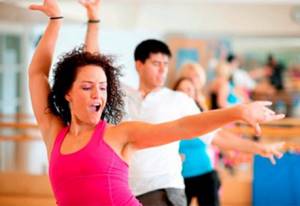
Girls doing dance aerobics in a group
- a small mat (if you don’t have a special sports mat, you can use a regular one);
- a mirror (which will help you with motivation, since thanks to it you will be able to observe your own successes in the “here and now” mode);
- a specific set of aerobics exercises for weight loss, which you can find ready-made on the Internet or collect from various sources yourself, depending on your personal preferences and interests.
for beginners it is better to use proven aerobics techniques for weight loss for beginnerspurchase steppe
Step aerobics for weight loss
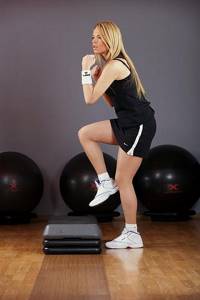
The stepper can be used at home, dance and lose weight! Step aerobics sport is an integral part of a healthy lifestyle when doing aerobics the emphasis is on breathing and heartbeat located here
It is imperative to start with a warm-up so that such a heart rate develops gradually. You also need to stop immediately, but gradually reduce the load. A sharp increase or decrease in speed can adversely affect the functioning of the heart. The main set of aerobic exercises includes stretching, flexibility, and strength exercises. While performing them, you should carefully monitor your breathing and pulse rate.
If they get confused or gain too much speed, it is important to slow down a little and reduce the load. With regular aerobic exercises, exercises will become easier for you - and then you will be able to take on something more difficult, perform tasks that are not intended for beginners.
Aerobics lessons for weight loss
- Place one of your feet on the step and after a few seconds place the other one next to it. At the same pace and order, lower both legs to the floor. Repeat this procedure several times, gradually increasing the pace. Then do the same, starting with the other leg.
- Place one leg on the step, first bending it at the knee. Raise your other leg and hold it above the floor for a couple of seconds. Perform this exercise, alternating legs, 10-15 times.
- Stand on the step with one foot, and bend the other at the knee, pulling it up. Then lower the raised leg to the floor and place the one that was on the steppe next to it. Repeat this exercise 10-15 times on one leg, and then the same number on the other.
if your goal is to quickly lose weight and maintain this result in the future, then aerobics for weight loss should become part of your life
Training program to combat extra pounds
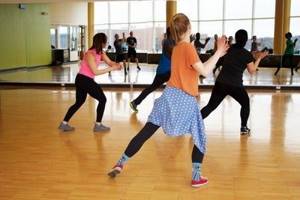
Steppers are equipment belonging to the cardio group. One of its varieties - a mini-stepper - imitates walking on steps. It allows you to work out and improve the definition of your buttocks, legs and thighs.
When working with a mini-stepper you cannot:
- bring your knees inward;
- lean only on your toes;
- allow your heels to hang down;
- take sudden steps.
In order to maintain weight, it is enough to exercise 20-25 minutes a day, but to reduce it, it is worth increasing the training time to 40-60 minutes. It is in the last quarter of an hour that the fat layer will be burned most intensively. During the training process, you need to monitor your heart rate. It should be between 110-140 beats per minute.
The fastest way to get rid of calories will be the following program, consisting of 3 circles. Each will have the following sets:
- steps at a calm pace (5 minutes);
- medium pace (4 minutes);
- maximum possible pace (1 minute).
The speed can be adjusted on the machine itself.
Training requires a preliminary warm-up before it and subsequent muscle stretching. At the end of classes, it will be enough to bend over and restore your breathing.
If there is an expander on the simulator, you can connect elements to the biceps and shoulder girdle. For example;
- walking with high knees;
- swing your arms;
- balancing on one leg with arms raised.
If you don’t have an expander, you can use light dumbbells or half-liter water bottles (at home).
All exercises performed must be consistent with the rhythm of steps. Advanced athletes can increase the training time to 1.5 hours. You need to exercise at least 3 times a week. Thus, in a month of regular training you can lose up to 5 kg of weight.
How can you speed up the result?

There are several rules that will not only improve the results of training on the stepper, but also consolidate them:
- The last meal should take place at least 1.5-2 hours before classes.
- Breathing during the implementation of the elements should be deep and even. He cannot be detained. In case of confusion, it is necessary to reduce the pace of training.
- You need to exercise 5-6 hours before bedtime, but not later. Otherwise, sleep will be unproductive (lipolysis processes are activated at night).
- After your workout, you can drink a glass of water. The next meal should be no earlier than an hour later. It is desirable that it be based on proteins.
- The process of losing weight should be accompanied by dietary restrictions, namely a reduction in the amount of simple carbohydrates in the diet.
The more intense the workout, the more calories are burned. When actively losing weight, it is necessary to ensure monitoring of the condition. If you feel dizzy or weak, exercise should be suspended.
Advice from athletes
Gina Miller, creator of step aerobics
The author of one of the most famous areas initially developed this area, including as one of the types of rehabilitation of joint injuries. Over time, it was revealed that the direction is very promising in terms of losing weight and increasing endurance, but only in the case of high-intensity long-term training.
Katie Smith, American video trainer, author of The Matrix Method

In her video training, Katie often resorts to elements of step aerobics, believing that this is an excellent way to achieve slim hips and legs, accessible to both beginners and more experienced athletes.
Jane Fonda, American actress, producer, “queen of American aerobics”
It is this actress who is credited with the invention of fitness aerobics. At 80 years old, her figure is living proof of the effectiveness of this trend. Jane Fonda's workouts also include step aerobics, which she ends with 10-minute abdominal exercises.
Strengthening joints and ligaments
The creator of step aerobics, Jean Miller, suffered a knee injury. While exercising on the platform, she noticed that the knee joint was subjected to minimal stress, and her overall health improved. By accelerating blood circulation, beneficial substances enter the joint tissues faster, ensuring their restoration.
Aerobic exercise helps in recovery from knee injuries.
During exercise on the step platform, the production of fluid increases, which serves as a natural lubricant for the joint. Thanks to this, his mobility improves. To avoid harming yourself, choose low-intensity workouts.
Main conclusions
Step aerobics is one of the most popular areas of fitness, allowing you not only to lose weight, but also to improve the shape of the main “feminine virtues” - legs, buttocks and thighs:
- This type of training develops endurance and improves the functioning of the cardiovascular system.
- The main “base” allows you to create many combinations that load different muscle groups.
- Losing weight is only possible with high-intensity training 2-4 times a week.
- You need to do step aerobics for at least an hour, but beginners should start with 40-45 minutes.
- One session burns from 300 to 600 calories, depending on the intensity.
You can lose weight and get tangible results from step aerobics only while sticking to a diet.
Doctors' opinions on the effectiveness and safety of training
You can often hear statements that step aerobics “kills” the knee joints and ankles.
Is this really so or is it the machinations of skeptics and envious people? If you are obese, then your joints are at risk in any case. And if you are already over 35, then the deficiency of female hormones gradually makes itself felt through thinning of the bones and the development of osteoporosis. It is desirable to reduce the impact loads on joints and bones as much as possible, and step aerobics is designed specifically for them, especially if you do it intensively, wanting to lose weight.
We can conclude that this is fitness for young and healthy people. And for slightly older women, it is better to pay attention to static loads that do not require jumping and steps, after which creaks and pain in the knees will appear.
